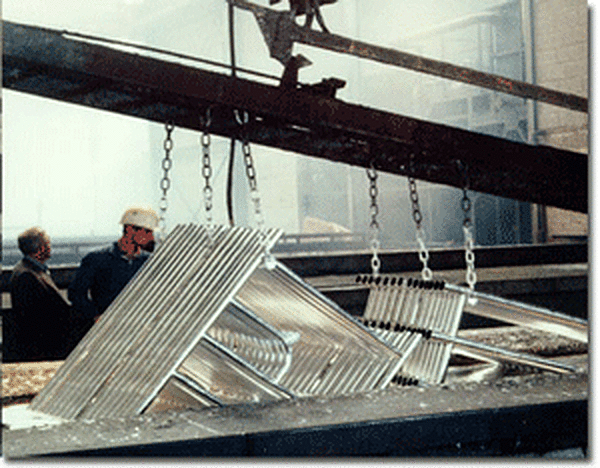Stripping and Re-Dipping Galvanized Steel
Does stripping and re-dipping galvanized steel damage the steel?

Hot-dip galvanized steel is stripped and re-dipped for several reasons. When galvanized steel comes out of the kettle with bare areas exceeding the limits listed in ASTM A123/A123M (1/2 of 1% of the total surface area), the steel must be stripped and re-dipped. On steel with reactive chemistry, the coating can grow to excessive levels (greater than 10 mils) and then flake off the steel. The hope is stripping and re-dipping these kinds of steel will create a thinner galvanized coating the second time through the galvanizing process, as some of the silicon in the steel (a catalyst in the galvanizing reaction) is partially consumed the first time through the process. If the galvanized coating is still excessively thick after galvanizing it a second time, rather than simply stripping and re-dipping it a third time, blast the steel after stripping it the second time. This is a worst-case scenario, however. If you know you are dealing with reactive steel that develops an excessively thick coating, blasting the steel prior to going through the galvanizing process can save you from having to strip and re-dip the steel.
Due to the chemical cleaning process, stripping and re-galvanizing steel can affect the surface profile or chemistry of the steel which in turn will affect the properties of the galvanized coating. Very reactive steels, for example, may pick up an excessively thick coating upon being galvanized the first time and experience unwanted flaking of the coating. If these pieces are stripped and re-dipped, the resulting coating may be much thinner the second time around as some of the silicon near the surface of the steel was consumed during the first galvanizing operation and isnt available during the second. On the other hand, steel that has produced a coating that is too thin may benefit from the necessary stripping and re-dipping in order to meet the required minimum coating thickness average. The second chemical cleaning process may profile the surface of the steel enough to produce a thicker coating.
Lastly, sometimes galvanized steel is stripped and re-dipped when it has been in service for some time and its galvanized coating has been nearly consumed. When this type of steel is stripped and re-dipped, it is important to look at its condition. Some galvanizing customers mistakenly believe the galvanizing process will fill in dimples and holes in the steel, which is not the case. Rather, the galvanized coating will follow the shape of steel and reveal what the steel surface looked like before galvanizing. To answer the question of whether stripping and re-dipping damages steel, stripping and re-dipping galvanized steel does not damage the steel in terms of mechanical properties. Sometimes customers are concerned that chemical cleaning the steel a second time increases the chances for hydrogen embrittlement. This is not a concern for steel that has a tensile strength under 150 ksi. Hopefully, you dont have to do a lot of stripping and re-dipping, since it costs you time and money. But for those rare occasions when you do, youll know it doesnt hurt your customers steel.
© 2025 American Galvanizers Association. The material provided herein has been developed to provide accurate and authoritative information about after-fabrication hot-dip galvanized steel. This material provides general information only and is not intended as a substitute for competent professional examination and verification as to suitability and applicability. The information provided herein is not intended as a representation or warranty on the part of the AGA. Anyone making use of this information assumes all liability arising from such use.

